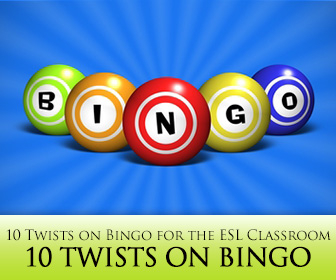Opposites Attract: Having Fun with Antonyms


It is versatile, simple, and fun. I have played many different versions of Bingo depending on what I happen to be teaching, and Bingo is flexible enough that I can tailor it to just about anything. Here are ten twists on the classic game that you can include in your ESL class, too.

This version of the game tests your students’ ability to listen to a word and choose the correct picture on their bingo board. It works best with vocabulary that is easily illustrated. Start by having students create their bingo boards using pictures of the vocabulary you will use during the game. At the start of play, choose a word and read it to your students. Do not let them see the word or a picture of it. Your students will have to use their listening skills to identify the correct picture on their boards. As always, five in a row wins.
Similar to Listening Comprehension Bingo, Reading Comprehension Bingo starts with students selecting pictures to fill the squares on their Bingo boards. During play, you choose one word at a time and this time show the written word to your students. The class reads the word and marks the correct picture on their Bingo boards.
I love teaching vocabulary words in groups, that is, teaching three or four words with similar meanings at the same time rather than teaching a list of unrelated words. If you teach this way, and even if you don’t, synonym Bingo is a good way to review related vocabulary words. Students fill in their Bingo boards with various vocabulary words in random order. You choose synonyms for each of the words. To play, announce one of the words you have selected to your students. If a student has a synonym of the word you have chosen, she can mark it on her board. She cannot mark the actual words you show the class. Once she gets five synonyms in a row, she calls out Bingo.
Antonym Bingo plays in much the same way as synonym Bingo except that you choose antonyms rather than synonyms for the words on your students’ cards. To check after a student calls Bingo, have them read the words they marked along with the antonyms you called out to the class.
When I am teaching conditionals, I like to play problem and advice Bingo with my students. It not only challenges them to put together conditional sentences, it makes them think logically about what to do in a given situation. To play, students fill their boards with advice they might give a friend. These advice phrases should start with “I would…” (Hint: the more general the advice, the more likely your students will be able to match them to a problem.) Your part is to call out problems that a person could have. They can be realistic or ridiculous, depending on the personality of your class. To play, you read the problem and your students choose the advice on their board that best addresses the situation. Once someone calls Bingo, post the problems that you have called on the board so your students can see them. Then, when the winner reads off his winning answers, he must put them into a complete sentence using the conditional form. For example, if you called the problem “I lost my dog” a student might choose to cover “I would call the police.” His sentence would be, “If I lost my dog, I would call the police.” Let the class decide if the winning player has chosen legitimate advice for each problem.
Beginning level students will enjoy this game that reviews colors. Have students write the names of colors to fill in their Bingo boards. (Note: Depending on how many colors your students are reviewing, you might want to use a three by three or four by four board rather than the traditional five by five.) Either show students a picture of the color and have them mark the color on their board or call out an object that is usually associated with a particular color (e.g. sky for blue, grass for green), and have students mark the correct color on their board.
This is a challenging review of the verb tenses in English for advanced students. Have students choose two or three verbs and write the conjugation for those verbs in all twelve English verb tenses in random order on their boards. Tell students they must include at least one conjugation in each of the twelve tenses. You should have ready sentences that clearly call for each of the twelve conjugations of each verb. Read them in random order leaving out the verb. If students have the correct verb form on their Bingo board to complete your sentence, they mark it off. Remind students not to clear their boards when someone calls Bingo until that person’s answers have been checked.
No matter what holiday is coming up, you can probably find a set of Bingo cards online. Review the holiday specific vocabulary with your students and then either play listening comprehension or reading comprehension Bingo with the seasonal words. This is a good way to bring vocabulary into your classroom that you might not cover in traditional ESL units.
If you want your students to be on the lookout for vocabulary they learned for a specific field trip, you might want to try field trip Bingo. Students prepare their boards by filling in spaces with vocabulary they learn specifically for the trip. Students bring their cards with them on the field trip and mark off words as they encounter them. Rather than calling out when they have five in a row, students bring their boards over to you secretly. You check to see if their marks are correct. Students should continue to mark words throughout the field trip. When you return to school, award points for each Bingo a student was able to make (traditional, four corners, cross, X, outline the board, etc.) The student with the most points wins a prize – perhaps something you purchased on the field trip.
While variations on the game are great, don’t forget the value that traditional Bingo has to offer. It is great for reviewing numbers with your students, and ESL students can always use practice with numbers.
If you are like me and use Bingo in the classroom on a regular basis, you might want to create reusable Bingo boards for your students. To do this, print a blank Bingo board and laminate it. Students can then use dry erase markers to fill in the boxes. You can also make boards from cardboard or cardstock (slip them in plastic sleeves if you like) and put Velcro dots on each square. When students make their own boards, they select from pictures and words that have Velcro on the back and simply stick them on the Velcro areas on the blank board.
What variations have you used?